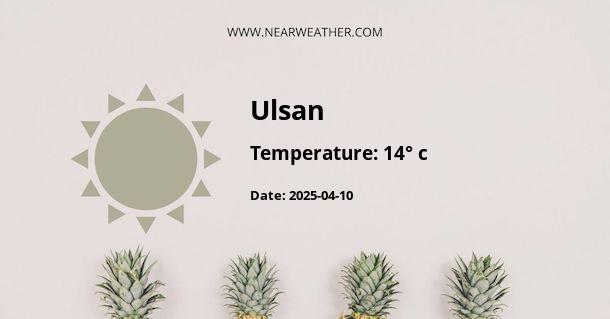Climate and Weather in Ulsan-gwangyŏksi, South Korea
Ulsan-gwangyŏksi, commonly known as Ulsan, is a metropolitan city located in the southeastern part of South Korea. With its vibrant economy and rich cultural heritage, Ulsan attracts both tourists and professionals from around the world. Understanding the climate and weather patterns of this region is essential for planning trips, outdoor activities, and even long-term stays. Let's take a closer look at the climate and weather in Ulsan-gwangyŏksi throughout the year.
Climate Classification
Ulsan-gwangyŏksi experiences a humid subtropical climate, also known as a warm temperate climate, which is influenced by its coastal location and the surrounding mountain ranges. This classification results in mild winters and hot, humid summers. The city is also prone to typhoons during the late summer and early autumn months.
Seasonal Temperatures
Ulsan-gwangyŏksi has distinct seasons, each with its own unique temperature range. Here is a breakdown of the average temperatures you can expect during each season:
| Season | Average Temperature (°C) |
|---|---|
| Spring (March - May) | 8°C - 19°C |
| Summer (June - August) | 21°C - 29°C |
| Autumn (September - November) | 14°C - 25°C |
| Winter (December - February) | -3°C - 7°C |
As seen from the table, Ulsan-gwangyŏksi experiences pleasant temperatures during spring and autumn, making these seasons ideal for outdoor activities and sightseeing. Summers can be hot and humid, with temperatures often reaching the high 20s or even low 30s (°C). Winters are relatively mild, but temperatures can drop below freezing, especially during the night. It is important to pack accordingly and plan activities accordingly, depending on the season.
Rainfall and Precipitation
Ulsan-gwangyŏksi receives a moderate amount of rainfall throughout the year, with the wettest months being July and August. The city experiences a monsoon season during these months, characterized by heavy rainfall and occasional thunderstorms. The average annual precipitation in Ulsan-gwangyŏksi is around 1,200mm.
Here is a breakdown of the average monthly rainfall in Ulsan-gwangyŏksi:
| Month | Average Rainfall (mm) |
|---|---|
| January | 28mm |
| February | 36mm |
| March | 57mm |
| April | 76mm |
| May | 82mm |
| June | 165mm |
| July | 330mm |
| August | 314mm |
| September | 103mm |
| October | 41mm |
| November | 28mm |
| December | 23mm |
It is advisable to carry an umbrella or raincoat when visiting Ulsan-gwangyŏksi, especially during the summer months, to stay prepared for occasional rainfall.
Typhoons
Ulsan-gwangyŏksi is susceptible to typhoons, particularly during the late summer and early autumn months. These powerful tropical storms can bring heavy rain, strong winds, and potential flooding. The typhoon season in South Korea typically lasts from July to September, with August being the most active month.
Best Time to Visit
The best time to visit Ulsan-gwangyŏksi is during spring (March to May) and autumn (September to November). These seasons offer comfortable temperatures, less rainfall, and beautiful natural scenery. However, if you enjoy the warmth and vibrant atmosphere of summer, you can plan your visit during June to August.
It is important to note that Ulsan-gwangyŏksi hosts various festivals and events throughout the year, such as the Ulsan Whale Festival in April and the Ulsan Grand Park Cherry Blossom Festival in April. Consider checking the local event calendar to align your visit with any special events that interest you.
Overall, Ulsan-gwangyŏksi experiences a humid subtropical climate with mild winters, hot summers, and moderate rainfall. Understanding the weather patterns and seasons will help you make the most of your time in this vibrant city.
A - Ulsan's Latitude is 35.566669 & Longitude is 129.266663.
A - Weather in Ulsan is 14° today.
A - Climate Conditions in Ulsan shows broken clouds today.
A - Humidity in Ulsan is 75% today.
A - Wind speed in Ulsan is 8.6 km/h, flowing at 40° wind direction. today.
